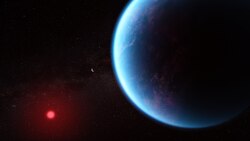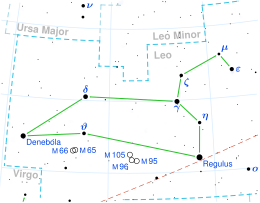Approximate two-dimensional location of the star (in red circle); Sigma Leonis is the nearest bright star, which is in a southerly direction, and the boundary of Virgo is similarly far. | |
| Observation data Epoch J2000.0 Equinox J2000.0 | |
|---|---|
| Constellation | Leo |
| Right ascension | 11h 30m 14.51774s[1] |
| Declination | +07° 35′ 18.2553″[1] |
| Apparent magnitude (V) | 13.50[2] |
| Characteristics | |
| Evolutionary stage | Red dwarf |
| Spectral type | M2.8[3] |
| Astrometry | |
| Radial velocity (Rv) | 0.02±0.52[1] km/s |
| Proper motion (μ) | RA: −80.479 mas/yr[1] Dec.: −133.007 mas/yr[1] |
| Parallax (π) | 26.2469 ± 0.0266 mas[1] |
| Distance | 124.3 ± 0.1 ly (38.10 ± 0.04 pc) |
| Details | |
| Mass | 0.495±0.004[4] M☉ |
| Radius | 0.469±0.010[4] R☉ |
| Luminosity | 0.0234[5] L☉ |
| Temperature | 3,503±60[4] K |
| Metallicity [Fe/H] | 0.123±0.157[6] dex |
| Rotation | 39.6±0.9 d[7] |
| Age | 2.4±0.6[7] Gyr |
| Other designations | |
| Database references | |
| SIMBAD | data |
K2-18, also known as EPIC 201912552, is a red dwarf star with two planetary companions located 124 light-years (38 parsecs)[4] from Earth, in the constellation of Leo.
Its name is due to the fact that it was discovered by the K2 Mission, which extended the mission of the Kepler Space Telescope after failure of two of its reaction wheels.
YouTube Encyclopedic
-
1/5Views:25 096200 01081 51952 4601 515
-
Has the James Webb Space Telescope Found Extraterrestrial Life on K2-18B?
-
James Webb Telescope Discovered Planet Even Better for Life Than Earth
-
The James Webb Space Telescope Has Discovered a Planet That Is More Suitable for Life than Earth!
-
Is Planet K2-18B Suitable For Life? #shorts
-
K2 18B || Nasa Discovered New Exoplanet With Possible Of Alien Life ? || #planet @7space
Transcription
Planetary system
The star has a transiting exoplanet, called K2-18b, a super-Earth located within the habitable zone of K2-18.[9][10] It was discovered in 2015 by the Kepler space telescope in its K2 mission.[3] It is the first exoplanet in the habitable zone, albeit a hydrogen-rich sub-Neptune,[11] to have its atmosphere characterized; initially thought to contain water vapor,[12] more recent observations have instead detected methane and carbon dioxide.[13] The presence of these molecules and non-detection of ammonia is consistent with predictions for a hycean planet.[13]
A second, non-transiting planet, K2-18c, was discovered in 2017 by radial velocity with HARPS.[14] This planet was challenged by another team with CARMENES data,[15] but its existence was reaffirmed by the discovery team based on both HARPS and CARMENES data.[4] This planet has also been confirmed by a later independent study.[16] System tidal simulation suggests that K2-18c is a gas-rich, Neptune-like planet, similar to K2-18b.[17]
| Companion (in order from star) |
Mass | Semimajor axis (AU) |
Orbital period (days) |
Eccentricity | Inclination | Radius |
|---|---|---|---|---|---|---|
| c | ≥5.62±0.84 M🜨 | 0.0670 ± 0.0002 | 9.2072±0.0065[16] | <0.2 | — | — |
| b | 8.63±1.35 M🜨 | 0.1591±0.0004 | 32.94488±0.00281 | — | — | 2.711±0.065 R🜨 |
References
- ^ a b c d e Vallenari, A.; et al. (Gaia collaboration) (2023). "Gaia Data Release 3. Summary of the content and survey properties". Astronomy and Astrophysics. 674: A1. arXiv:2208.00211. Bibcode:2023A&A...674A...1G. doi:10.1051/0004-6361/202243940. S2CID 244398875. Gaia DR3 record for this source at VizieR.
- ^ Zacharias, N.; Finch, C. T.; Girard, T. M.; Henden, A.; Bartlett, J. L.; Monet, D. G.; Zacharias, M. I. (2012). "VizieR Online Data Catalog: UCAC4 Catalogue (Zacharias+, 2012)". VizieR On-line Data Catalog. Bibcode:2012yCat.1322....0Z.
- ^ a b Montet, Benjamin T.; et al. (5 August 2015). "Stellar and Planetary Properties of K2 Campaign 1 Candidates and Validation of 17 Planets, Including a Planet Receiving Earth-like Insolation". The Astrophysical Journal. 809 (1) 25: 25. arXiv:1503.07866. Bibcode:2015ApJ...809...25M. doi:10.1088/0004-637X/809/1/25. S2CID 33348734.
- ^ a b c d e Cloutier, Ryan; et al. (7 January 2019). "Confirmation of the radial velocity super-Earth K2-18c with HARPS and CARMENES". Astronomy & Astrophysics. 621 A49: A49. arXiv:1810.04731. Bibcode:2019A&A...621A..49C. doi:10.1051/0004-6361/201833995. S2CID 118828975.
- ^ Martinez, Arturo O.; et al. (2017). "Stellar and Planetary Parameters for K2's Late-type Dwarf Systems from C1 to C5". The Astrophysical Journal. 837 (1) 72: 72. arXiv:1701.00588. Bibcode:2017ApJ...837...72M. doi:10.3847/1538-4357/aa56c7. S2CID 25502982.
- ^ Benneke, Björn; et al. (2017). "Spitzer Observations Confirm and Rescue the Habitable-zone Super-Earth K2-18b for Future Characterization". The Astrophysical Journal. 834 (2) 187: 187. arXiv:1610.07249. Bibcode:2017ApJ...834..187B. doi:10.3847/1538-4357/834/2/187. S2CID 12988198.
- ^ a b Guinan, Edward F.; Engle, Scott G. (2019-12-12). "The K2-18b Planetary System: Estimates of the Age and X-UV Irradiances of a Habitable Zone "Wet" Sub-Neptune Planet". Research Notes of the AAS. 3 (12): 189. Bibcode:2019RNAAS...3..189G. doi:10.3847/2515-5172/ab6086. ISSN 2515-5172.
- ^ "K2-18". SIMBAD. Centre de données astronomiques de Strasbourg. Retrieved 2024-04-13.
- ^ "HABITABLE EXOPLANETS CATALOG". UPR. 7 March 2016. Retrieved 12 September 2019.
- ^ "EPIC 201912552 b reality check drewexmachina 11-22-2015". Drew ExMachina. 7 March 2016. Retrieved 12 September 2019.
- ^ No, the Exoplanet K2-18b Is Not Habitable
- ^ Benneke, Björn; Wong, Ian; Piaulet, Caroline; Knutson, Heather A.; Lothringer, Joshua; Morley, Caroline V.; Crossfield, Ian J. M.; Gao, Peter; Greene, Thomas P.; Dressing, Courtney; Dragomir, Diana; Howard, Andrew W.; McCullough, Peter R.; Kempton, Eliza M.-R.; Fortney, Jonathan J.; Fraine, Jonathan (December 2019). "Water Vapor and Clouds on the Habitable-zone Sub-Neptune Exoplanet K2-18b". The Astrophysical Journal Letters. 887 (1): L14. arXiv:1909.04642. Bibcode:2019ApJ...887L..14B. doi:10.3847/2041-8213/ab59dc. ISSN 2041-8205. S2CID 209324670.
- ^ a b Madhusudhan, Nikku; Sarkar, Subhajit; Constantinou, Savvas; Holmberg, Måns; Piette, Anjali A. A.; Moses, Julianne I. (1 October 2023). "Carbon-bearing Molecules in a Possible Hycean Atmosphere". The Astrophysical Journal Letters. 956 (1): L13. arXiv:2309.05566. Bibcode:2023ApJ...956L..13M. doi:10.3847/2041-8213/acf577.
- ^ Cloutier, R.; Astudillo-Defru, N.; et al. (December 2017). "Characterization of the K2-18 multi-planetary system with HARPS. A habitable zone super-Earth and discovery of a second, warm super-Earth on a non-coplanar orbit". Astronomy & Astrophysics. 608: A35. arXiv:1707.04292. Bibcode:2017A&A...608A..35C. doi:10.1051/0004-6361/201731558.
- ^ Sarkis, Paula; Henning, Thomas; et al. (June 2018). "The CARMENES Search for Exoplanets around M Dwarfs: A Low-mass Planet in the Temperate Zone of the Nearby K2-18". The Astronomical Journal. 155 (6): 257. arXiv:1805.00830. Bibcode:2018AJ....155..257S. doi:10.3847/1538-3881/aac108.
- ^ a b Radica, Michael; Artigau, Étienne; et al. (December 2022). "Revisiting radial velocity measurements of the K2-18 system with the line-by-line framework". Monthly Notices of the Royal Astronomical Society. 517 (4): 5050–5062. arXiv:2210.08078. Bibcode:2022MNRAS.517.5050R. doi:10.1093/mnras/stac3024.
- ^ a b Ferraz-Mello, S.; Gomes, G. O. (2020). "Tidal evolution of exoplanetary systems hosting potentially habitable exoplanets. The cases of LHS-1140 b-c and K2-18 b-c". Monthly Notices of the Royal Astronomical Society. 494 (4): 5082–5090. arXiv:2005.10318. Bibcode:2020MNRAS.494.5082G. doi:10.1093/mnras/staa1110. S2CID 218763252.


